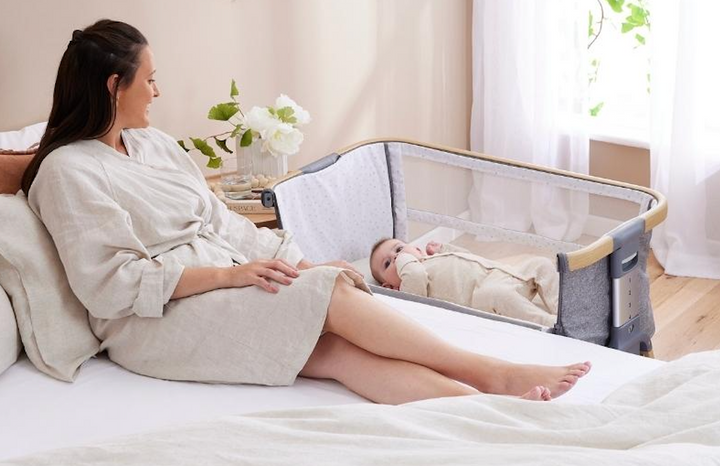What is Co-Sleeping?
You’ve probably heard the phrase “co-sleeping” and if you have, you’ll know it tends to get a bit of bad rap. Concerns around infant safety have driven a burgeoning sense of fear amongst parents in recent decades, causing them to steer away from co-sleeping entirely. The good news is, there IS a way to co-sleep with your baby while also abiding by Safe Sleep guidelines.
First, let’s get clear on different types of co-sleeping.
1. Bed sharing
This refers to parents who sleep with their baby in bed with them. Although the idea of snuggling up to your baby at night sounds like a nice one, it’s not considered safe. Why? Because it increases your baby’s risk of Sudden Unexpected Death in Infancy (SUDI), including Sudden Infant Death Syndrome (SIDS) and fatal sleeping accidents. Firstly, adult bedding and mattresses are often too soft for a baby whose neck muscles are underdeveloped. A soft surface allows a baby’s chin to tilt forward, causing an obstruction of their airways. What’s more, loose sheets and blankets can very easily end up over a baby’s face and increase their risk of suffocation. Unfortunately, there have been many cases of accidental suffocation by a parent when bed-sharing, either because of dangerous bedding or because a parent has rolled on top of their baby unknowingly.
2. Room sharing
Red Nose Australia encourages room sharing with your baby until at least 6 months of age. Room sharing involves putting a baby to sleep in their own flat, sleep space - either a bassinet or cot - in the same room as their parents. It means both adults and baby sleep in the same room, but they have very separate sleep spaces.
So why bother? Well, there’s a few reasons. The most obvious being that it makes feeding your baby overnight significantly easier if they’re close by, as opposed to in another room. There’s a good argument for room sharing when it comes to safety too. Studies have shown room sharing can reduce the likelihood of SUDI, because sensory stimulation (like parental movement, noise, and smells) can keep babies from moving into a deep sleep, thereby supporting protective airway responses.
3. Sofa sharing
It might sound obscure, but sofa sharing has become somewhat of an accidental sleep arrangement, where one parent takes the baby onto the couch to allow the other parent some much needed shut-eye. Most people don’t plan to sofa-share, but it happens so frequently that Red Nose Australia has given it a label, and recommends strongly against it. Not only is a couch or sofa too soft to qualify as a safe sleep surface for a baby, there is also a very big risk of a parent falling asleep and either dropping their baby, or unintentionally wedging the baby into cushions or the back of the sofa.
4. “Side car” or co-sleeper bassinets/cots
Welcome to the best of both worlds! Co-sleeper bassinets allow parents to co-sleep with their baby, while also ensuring their sleep space meets Red Nose guidelines. iL Tutto’s co-sleeping bassinets attach directly to the parent’s bed, which allows parents to stay close to their baby, while also ensuring their baby’s mattress is firm enough. With their own sleep space, it also means bub can be kept far enough away from adult bedding - it’s a win/win!
Whatever sleeping arrangement you choose for your family, it’s important to make sure safety is at the forefront of your priority list. Lots of cultures have co-slept with babies for thousands of years and those traditions can still be honoured, while taking all the necessary precautions to minimise SUDI risks.

For more info about all things baby sleep, head to sleepschool.co or visit their Instagram page @sleep_school.


